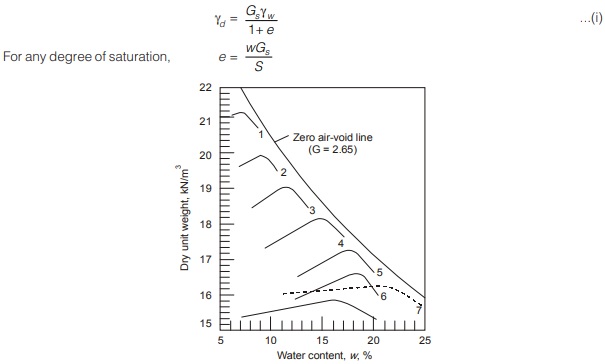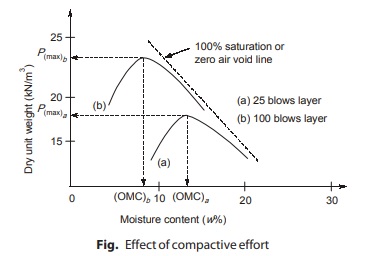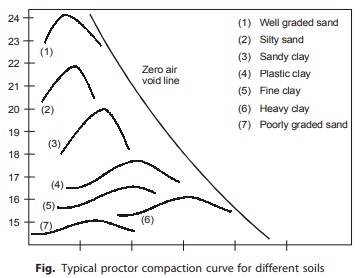Zero Air Void Line
At constant moisture content, the dry unit weight reaches its theoretical maximum when all the air is expelled from the void spaces, i.e. when degree of saturation is 100%. Therefore the zero air void line is a line joining points having dry unit weights corresponding to 100% saturation at different moisture contents. Therefore, it is also called the saturation line. Zero air void lines can be defined as “The lines showing the dry density as a function of water content for soil containing no air voids.”
We can derive its equation as follows:
|
Compaction curve |
Description of soil |
|
1 |
Well-graded to loamy sand (SW-SM) |
|
2 |
Well-graded sandy loam (SM) |
|
3 |
Med-graded sandy loam (SM) |
| 4 |
Lean sandy silty clay (CL) |
| 5 |
Lean silty clay (CI) |
|
6 |
Leossila silt (ML) |
| 7 |
Heavy clay (CH) |
| 8 |
Poorly graded sand (SP) |
Therefore we can write the expression for dry unit weight corresponding to any degree of saturation S as

CONSTANT PERCENTAGE AIR VOID LINES
The line which shows the water content, dry density relation for the compacted soil containing a constant percentage air void known as an air voids line.
FACTORS AFFECTING COMPACTION
The major factors which affect compaction are:
(i) Water content
(ii) Compactive effort
(iii) Type of soil
(iv) Method of compaction
(i) Water Content:
At lower water contents, the soil particles offer more resistance to compaction and soil behaves like a stiff material. Increasing the moisture content helps the particles to move closer because of the lubrication effect. On further increasing the moisture content beyond a certain limit, the water starts to replace the soil particles. Thus the dry unit weight continuous to increase till the Optimum Moisture Content (OMC) is reached and with further increase in moisture content beyond OMC, unit weight starts decreasing.
Lambe’s Explanation:
Lambe explain the effect of water content on dry unit weight using the concept of electrical double layer theory. In cohesive soils, there is an attractive force between the soil particles named as Vander Waal’s force and a repulsive force which is due to the double layers of adsorbed water. These repulsive forces are directly related to the size of double layers. While the attractive forces essentially remains the same in magnitude. At low water content, the double layer is not fully developed so the repulsive forces are small and net force acting between the particles will be attractive. This will result in the formation of flocculated structure. When the compaction is applied at low water content, the particles are not able to move closer to each other. As a consequence low dry density is obtained at lower water contents. As water content is increased, the double layer expands which results in an increase in interparticle repulsive force. The particles will easily slide over each other and tends to come closer. This will result in higher dry density. This expansion of double layer is complete at optimum moisture content and that is why the dry unit weight is maximum at this stage. On further addition of water content beyond OMC, water does not add any further to the expansion of double layer but water tends to occupy the space which otherwise would have been occupied by soil grains. It results in decrease in dry unit weight and also structure of soil will be dispersed after OMC.
(ii) Compactive Effort:
For a given type of compaction, an increase in the amount of compaction will initially result in closer packing of the soil particles and maximum dry unit weight increase while the optimum moisture content at which it is attained decreases.

If large compactive efforts are applied when the soil is on wet of optimum side, then it will not increase the density significantly. However excess pore water pressure may built up which leads to the following effects:
- Slope instability.
- This excess pore water pressure may later dissipate causing consolidation settlement.
(iii) Type of Soil
- Coarse grained soils, well graded can be compacted to high dry unit weight, especially if they contains some fines.
- However, if quantity of fines is excessive the maximum dry unit weight decreases.
- Poorly graded or uniform sands lead to lowest dry unit weight value.
- In clayey soils, maximum dry unit weight tends to decrease as plasticity increases.
- Cohesive soils have generally high value of OMC.
- Heavy clays with high plasticity have very low value of maximum dry unit weight and very high value of OMC.

(iv) Method of Compaction:
Since the field compaction is essentially a kneading or rolling type compaction whereas the laboratory tests are dynamic-impact type compaction, therefore, laboratory compaction tests have more value of maximum dry unit weight.


